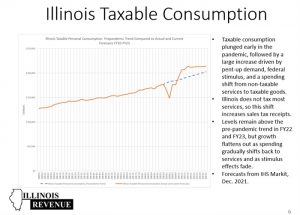State revenues $4.6 billion higher than initially projected
By Jerry Nowicki Capitol News Illinois — February 24, 2022
The windfalls in the big three revenue sources – individual and corporate income tax and sales tax – created unprecedented, at least in modern times, flexibility for the governor to craft a budget that sets up surpluses toward paying down old debts.
SPRINGFIELD – A House revenue committee on Thursday, Feb. 24 heard projections of an Illinois economy that is steadily moving back toward a level of pre-pandemic normalcy, which means revenue spikes realized due to temporary changes in consumer spending habits and federal stimulus packages are expected to subside.
Illinois Department of Revenue Director David Harris characterized the COVID-19 pandemic as a “black swan event” which sent state revenues tumbling by $400 million in 2020.
“A black swan is very rare, and rare events can happen and upset the financial apple cart,” Harris told the House Revenue and Finance Committee.
But in response to that so-called black swan event, consumers nationwide shifted to purchasing more goods than services, and the federal government provided direct financial payments to Americans and expanded unemployment insurance benefits.
That sparked a near two-year period of substantial state revenue growth, partially because Illinois taxes goods, but not most services, so the redistribution of spending correlated directly to a rise in sales tax revenue. As well, unemployment benefits are taxable by the state, and many individuals who collected enhanced federal benefits saw greater income levels than before the pandemic.
Corporations have made out OK as well, according to Harris.
“To give you an example, in December alone, just in December, we received $961 million in corporate income tax receipts,” he said. “That’s in one month. In a given year, a normal year would be $3.5 billion or thereabouts in corporate income tax receipts for the entire year.”
The windfalls in the big three revenue sources – individual and corporate income tax and sales tax – created unprecedented, at least in modern times, flexibility for Gov. JB Pritzker to craft a budget for the upcoming year that dedicates surpluses to paying down old debts. Negotiations on a final budget continue in the General Assembly.

A graphic from the Illinois Department of Revenue shows how taxable consumption was affected by the COVID-19 pandemic and related federal stimulus packages. (Illinois Department of Revenue)
Specifically, revenues for the fiscal year ending on June 30 are expected to be about $4.6 billion greater than were projected when the governor signed the budget into law last year, according to a presentation by the Commission on Government Forecasting and Accountability.
COGFA expects state coffers will have taken in $48.5 billion by the end of the fiscal year, up from a $44.4 billion projection in the budget that lawmakers approved in May. The base state revenue sources actually grew by $4.6 billion, however, because the governor’s office amended its planned use of federal funds to offset General Revenue Fund spending downward by $500 million due to the surplus.
The updated FY 22 estimates include a $1.6 billion increase in personal income tax from initial expected levels, a $1.2 billion increase in corporate income tax, and a $926 million increase in sales tax revenue.
The revenues for January alone were $1.2 billion greater than the prior year, according to COGFA.
Upcoming budget year
Harris and other fiscal prognosticators projected that Fiscal Year 2023, which begins July 1, will continue to see a solid revenue performance, but it will also begin a period of leveling, where the last two years of fiscal breathing room trend back to normal.
COGFA’s FY 23 revenue estimate is $671 million lower than its updated FY 22 estimate, not including federal funding. Federal American Rescue Plan Act funding accounts for $1.5 billion of the FY 22 budget but no such expenditures are anticipated for FY 23 in terms of GRF replacement funding.
But representatives of IDOR, COGFA and the Governor’s Office of Management and
Budget noted the picture for the upcoming fiscal year could change quickly as tensions continue amid the Russian invasion of Ukraine, which was escalating quickly at the time of the Thursday morning hearing.
“Will Russia’s invasion of Ukraine be a black swan event that causes disruptions that ripple across revenue streams? We do not know,” IDOR director Harris said. “But again, the trends so far are positive. And the forecasts presented today for FY 23 are positive ones.”

Illinois Department of Revenue Director David Harris
Republican lawmakers also inquired about inflation, and the budgeteers said projections generally anticipated “several months” of continued upward inflation before the trend reverses, and their current projections anticipate the inflation rate to be 7.9 percent.
Sustained Russian sanctions could impact anything from energy prices to the cost of wheat, so projections will be updated as needed, according to IDOR.
As the projections stand now, according to House Majority Leader Greg Harris, who is a chief budgeteer in the chamber, the governor and the General Assembly will have the flexibility to pay down old debt and prepare the state for future fiscal downturns.
Rep. Harris, who is not related to the IDOR director, said the preferred course is to use the major windfalls for one-time expenditures.
Included in the governor’s plan is an infusion of $600 million to the “rainy day” fund from the surplus in the current fiscal year, as well as $279 million from the upcoming fiscal year. That fund had been spent down to almost nothing during the budget impasse of 2015 to 2017.
The governor also proposed dedicating $898 million to pay down overdue health insurance bills. His proposal also includes spending $300 million of the surplus to pay down pension debt, with $200 million added to the statutory payment in the upcoming budget.
ARPA funding
The House committee, and Harris at the news conference, also discussed the state’s plan for the remaining American Rescue Plan Act funding. Illinois directly received $8.1 billion from President Joe Biden’s stimulus plan, and about $3.5 billion remains, Rep. Harris said.
He added that a working group made up of both parties as well as business and labor interests is currently discussing the plan for retiring $4.5 billion in debt to the federal government that the state incurred to keep its unemployment system running at the height of the pandemic. That borrowing has accrued $36 million of interest due by Sept. 30, according to the U.S. Treasury.
Republicans at the Thursday hearing suggested the governor reapportion his planned $1.5 billion in ARPA spending for FY 22, using it to pay down trust fund debt instead of replenishing state coffers for COVID-19-related spending.
Rep. Harris said the working group is coming up with a “menu of options” for paying down the backlog which could include ARPA funds. Generally, such a solution includes some combination of decreases to benefits, increases to employer premiums or some infusion of state, federal or private funding.
While Pritzker’s proposed FY 23 budget is largely not reliant on ARPA funds, one major proposed expenditure — $250 million for violence intervention funding — would be funded primarily by a $235 million lump sum from ARPA.
Rep. Harris said the intervention funding is often “short-term,” but the state will monitor the violence prevention program’s efficacy over the next few years as ARPA funding remains available and consider future expenditures in future budget years.
The governor’s plan to pay down debt with the one-time surplus this year could free up funds in the future, he said.
“Tens and tens of millions or hundreds of millions of dollars have been going out to repay debt that could otherwise be going to fund programs like that in future years,” he said of recently enacted budgets. “So being fiscally responsible now, it’s going to pay us a lot of dividends in the coming years.”







